2016 TOYOTA SIENNA display
[x] Cancel search: displayPage 294 of 668
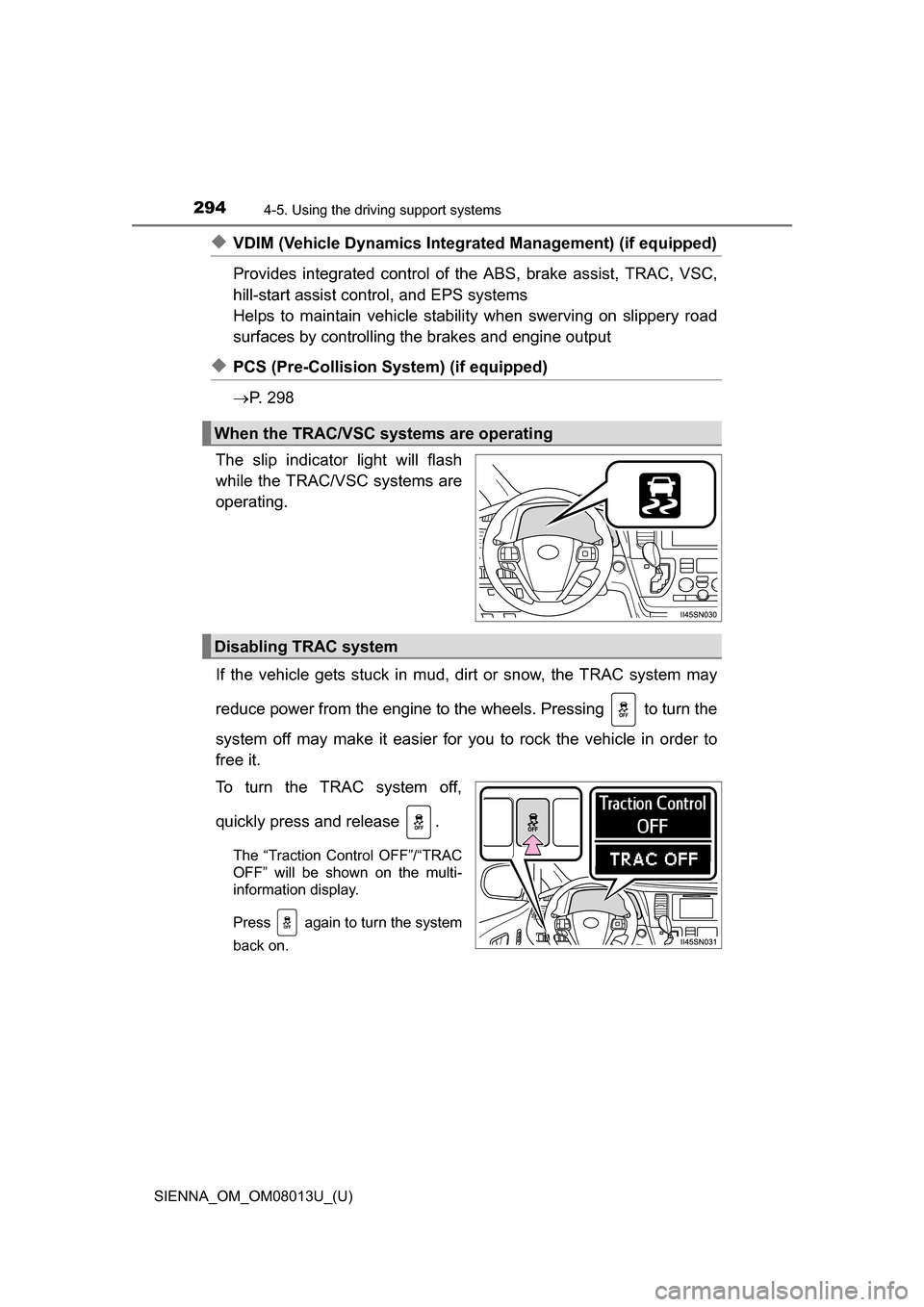
294
SIENNA_OM_OM08013U_(U)
4-5. Using the driving support systems
◆VDIM (Vehicle Dynamics Integr ated Management) (if equipped)
Provides integrated control of the ABS, brake assist, TRAC, VSC,
hill-start assist cont rol, and EPS systems
Helps to maintain vehicle stabilit y when swerving on slippery road
surfaces by controlling the brakes and engine output
◆PCS (Pre-Collision System) (if equipped)
P. 2 9 8
The slip indicator light will flash
while the TRAC/VSC systems are
operating.
If the vehicle gets stuck in mud, dirt or snow, the TRAC system may
reduce power from the engine to the wheels. Pressing to turn the
system off may make it easier for you to rock the vehicle in order to
free it.
To turn the TRAC system off,
quickly press and release .
The “Traction Control OFF”/“TRAC
OFF” will be shown on the multi-
information display.
Press again to turn the system
back on.
When the TRAC/VSC systems are operating
Disabling TRAC system
Page 295 of 668
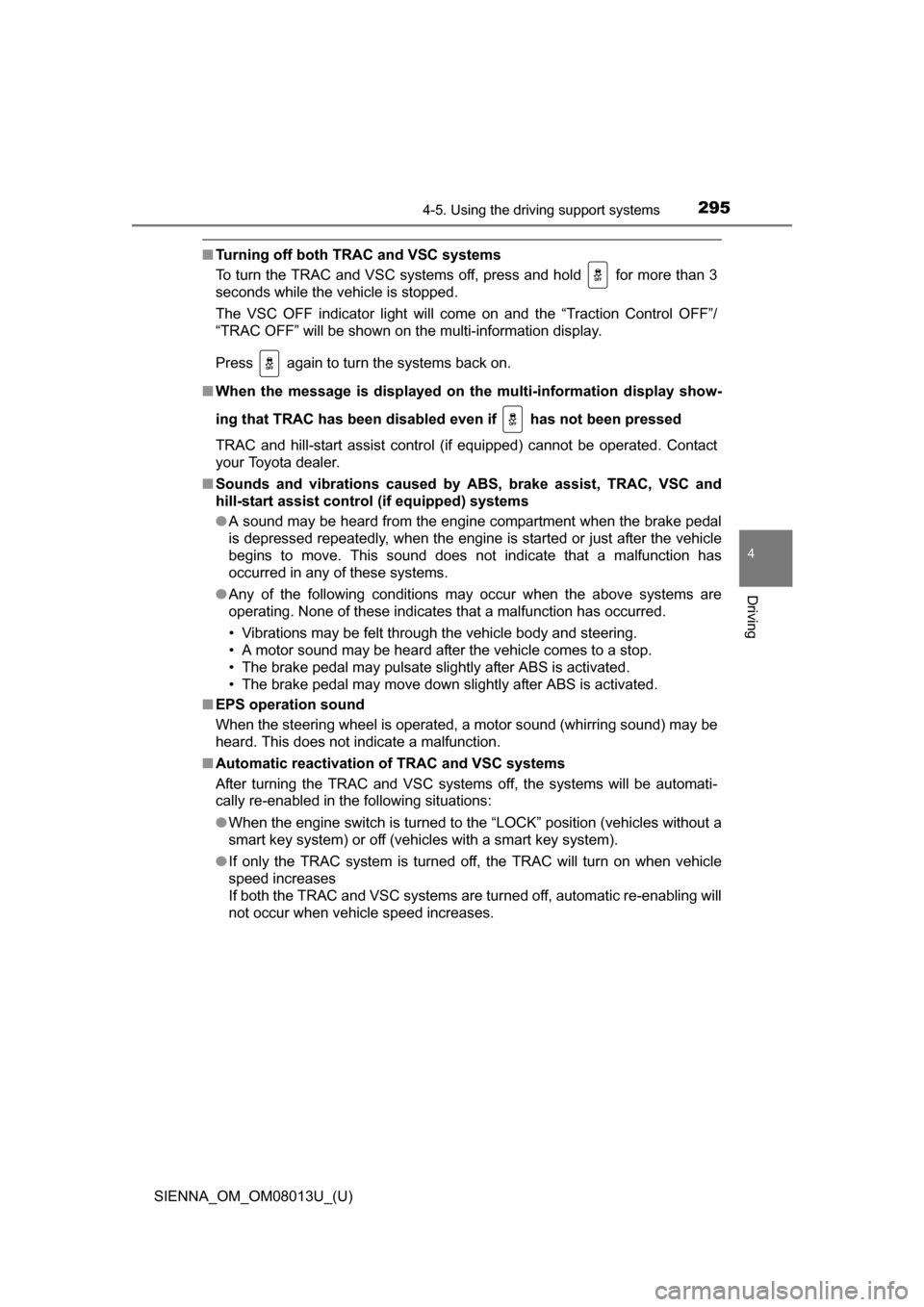
SIENNA_OM_OM08013U_(U)
2954-5. Using the driving support systems
4
Driving
■Turning off both TRAC and VSC systems
To turn the TRAC and VSC systems off, press and hold for more than 3
seconds while the vehicle is stopped.
The VSC OFF indicator light will come on and the “Traction Control OFF”/
“TRAC OFF” will be shown on the multi-information display.
Press again to turn the systems back on.
■ When the message is displayed on th e multi-information display show-
ing that TRAC has been disable d even if has not been pressed
TRAC and hill-start assist control (if equipped) cannot be operated. Contact
your Toyota dealer.
■ Sounds and vibrations caused by ABS, brake assist, TRAC, VSC and
hill-start assist contro l (if equipped) systems
● A sound may be heard from the engine compartment when the brake pedal
is depressed repeatedly, when the engine is started or just after the vehicle
begins to move. This sound does not indicate that a malfunction has
occurred in any of these systems.
● Any of the following conditions may occur when the above systems are
operating. None of these indicates that a malfunction has occurred.
• Vibrations may be felt through the vehicle body and steering.
• A motor sound may be heard after the vehicle comes to a stop.
• The brake pedal may pulsate slightly after ABS is activated.
• The brake pedal may move down slightly after ABS is activated.
■ EPS operation sound
When the steering wheel is operated, a motor sound (whirring sound) may be
heard. This does not indicate a malfunction.
■ Automatic reactivation of TRAC and VSC systems
After turning the TRAC and VSC systems off, the systems will be automati-
cally re-enabled in the following situations:
● When the engine switch is turned to the “LOCK” position (vehicles without a
smart key system) or off (vehicles with a smart key system).
● If only the TRAC system is turned off, the TRAC will turn on when vehicle
speed increases
If both the TRAC and VSC systems are turned off, automatic re-enabling will
not occur when vehicle speed increases.
Page 298 of 668
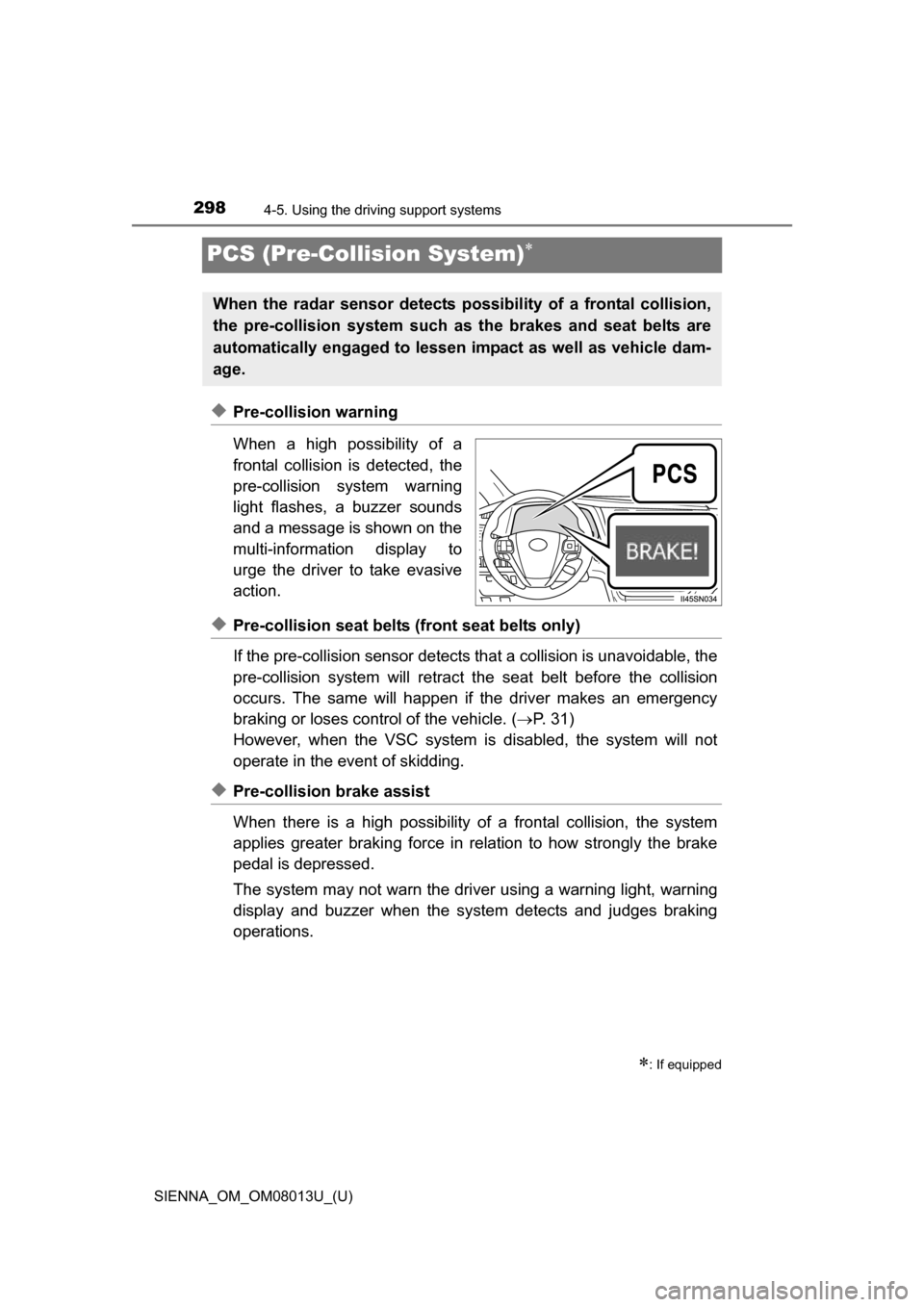
298
SIENNA_OM_OM08013U_(U)
4-5. Using the driving support systems
PCS (Pre-Collision System)
◆Pre-collision warning
When a high possibility of a
frontal collision is detected, the
pre-collision system warning
light flashes, a buzzer sounds
and a message is shown on the
multi-information display to
urge the driver to take evasive
action.
◆Pre-collision seat belts (front seat belts only)
If the pre-collision sensor detects that a collision is unavoidable, the
pre-collision system will retract the seat belt before the collision
occurs. The same will happen if the driver makes an emergency
braking or loses control of the vehicle. ( P. 3 1 )
However, when the VSC system is disabled, the system will not
operate in the event of skidding.
◆Pre-collision brake assist
When there is a high po ssibility of a frontal collision, the system
applies greater braking force in relation to how strongly the brake
pedal is depressed.
The system may not warn the driver using a warning light, warning
display and buzzer when the system detects and judges braking
operations.
: If equipped
When the radar sensor detects pos sibility of a frontal collision,
the pre-collision system such as the brakes and seat belts are
automatically engaged to lessen impact as well as vehicle dam-
age.
Page 299 of 668
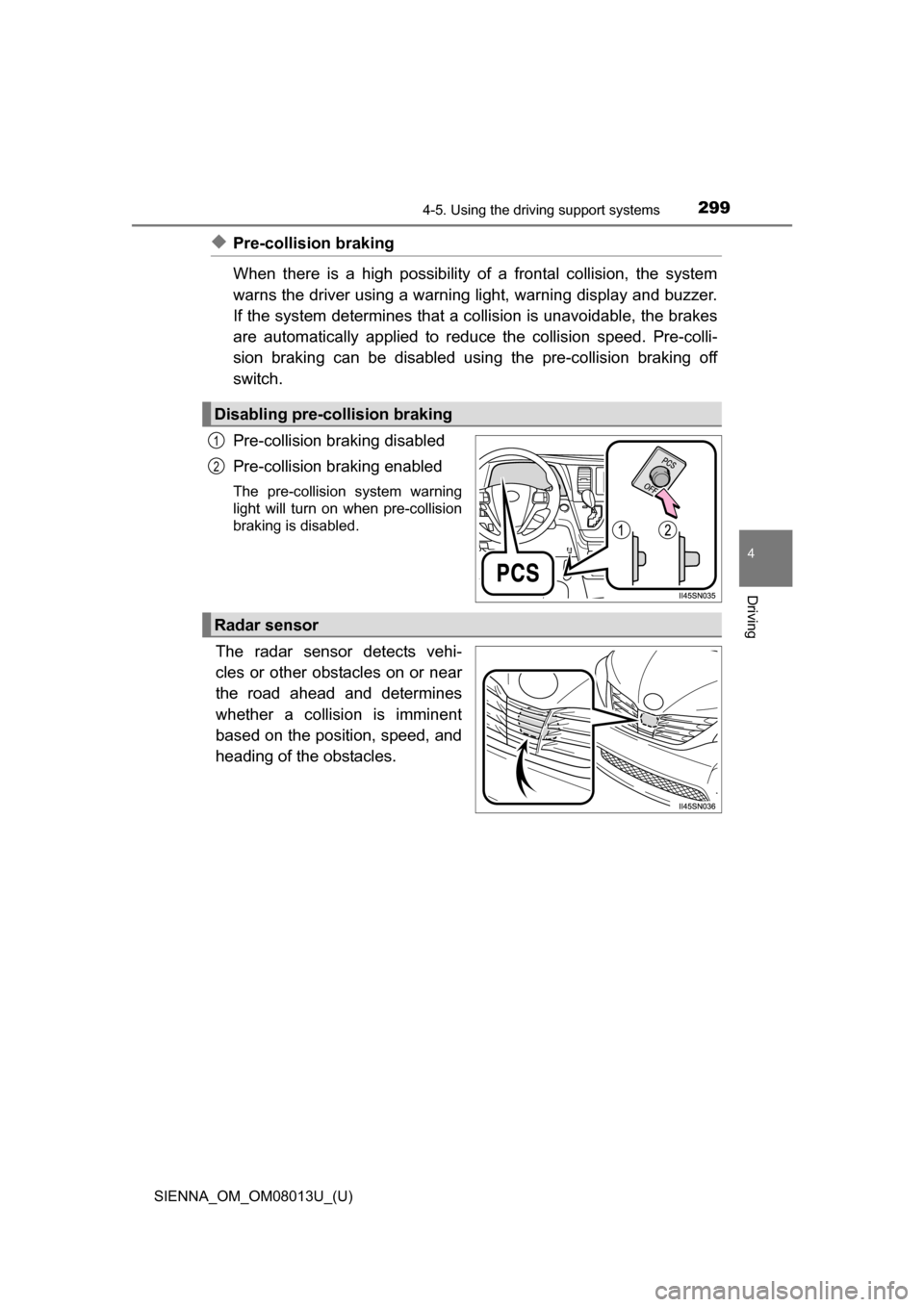
SIENNA_OM_OM08013U_(U)
2994-5. Using the driving support systems
4
Driving
◆Pre-collision braking
When there is a high po ssibility of a frontal collision, the system
warns the driver using a warning light, warning display and buzzer.
If the system determines that a collision is unavoidable, the brakes
are automatically applied to redu ce the collision speed. Pre-colli-
sion braking can be disabled usin g the pre-collision braking off
switch.
Pre-collision braking disabled
Pre-collision braking enabled
The pre-collision system warning
light will turn on when pre-collision
braking is disabled.
The radar sensor detects vehi-
cles or other obstacles on or near
the road ahead and determines
whether a collision is imminent
based on the position, speed, and
heading of the obstacles.
Disabling pre-collision braking
1
2
Radar sensor
Page 302 of 668
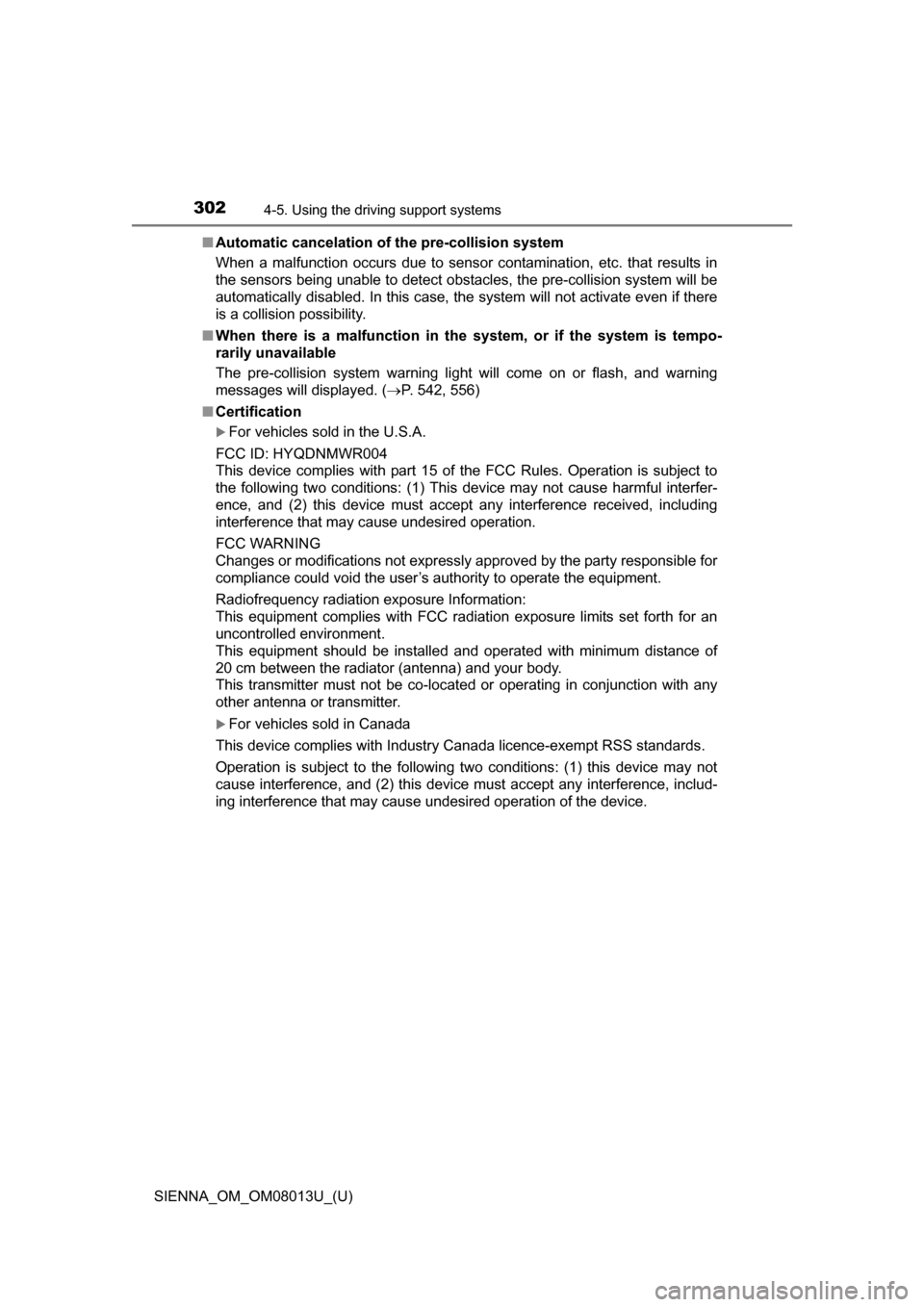
302
SIENNA_OM_OM08013U_(U)
4-5. Using the driving support systems
■Automatic cancelation of the pre-collision system
When a malfunction occurs due to sensor contamination, etc. that results in
the sensors being unable to detect obstacles, the pre-collision system will be
automatically disabled. In this case, the system will not activate even if there
is a collision possibility.
■ When there is a malfunction in the system, or if the system is tempo-
rarily unavailable
The pre-collision system warning light will come on or flash, and warning
messages will displayed. ( P. 542, 556)
■ Certification
For vehicles sold in the U.S.A.
FCC ID: HYQDNMWR004
This device complies with part 15 of the FCC Rules. Operation is subject to
the following two conditions: (1) This device may not cause harmful interfer-
ence, and (2) this device must accept any interference received, including
interference that may cause undesired operation.
FCC WARNING
Changes or modifications not expressly approved by the party responsible for
compliance could void the user’s authority to operate the equipment.
Radiofrequency radiation exposure Information:
This equipment complies with FCC radiation exposure limits set forth for an
uncontrolled environment.
This equipment should be installed and operated with minimum distance of
20 cm between the radiator (antenna) and your body.
This transmitter must not be co-located or operating in conjunction with any
other antenna or transmitter.
For vehicles sold in Canada
This device complies with Industry Canada licence-exempt RSS standards.
Operation is subject to the following two conditions: (1) this device may not
cause interference, and (2) this device must accept any interference, includ-
ing interference that may cause undesired operation of the device.
Page 306 of 668
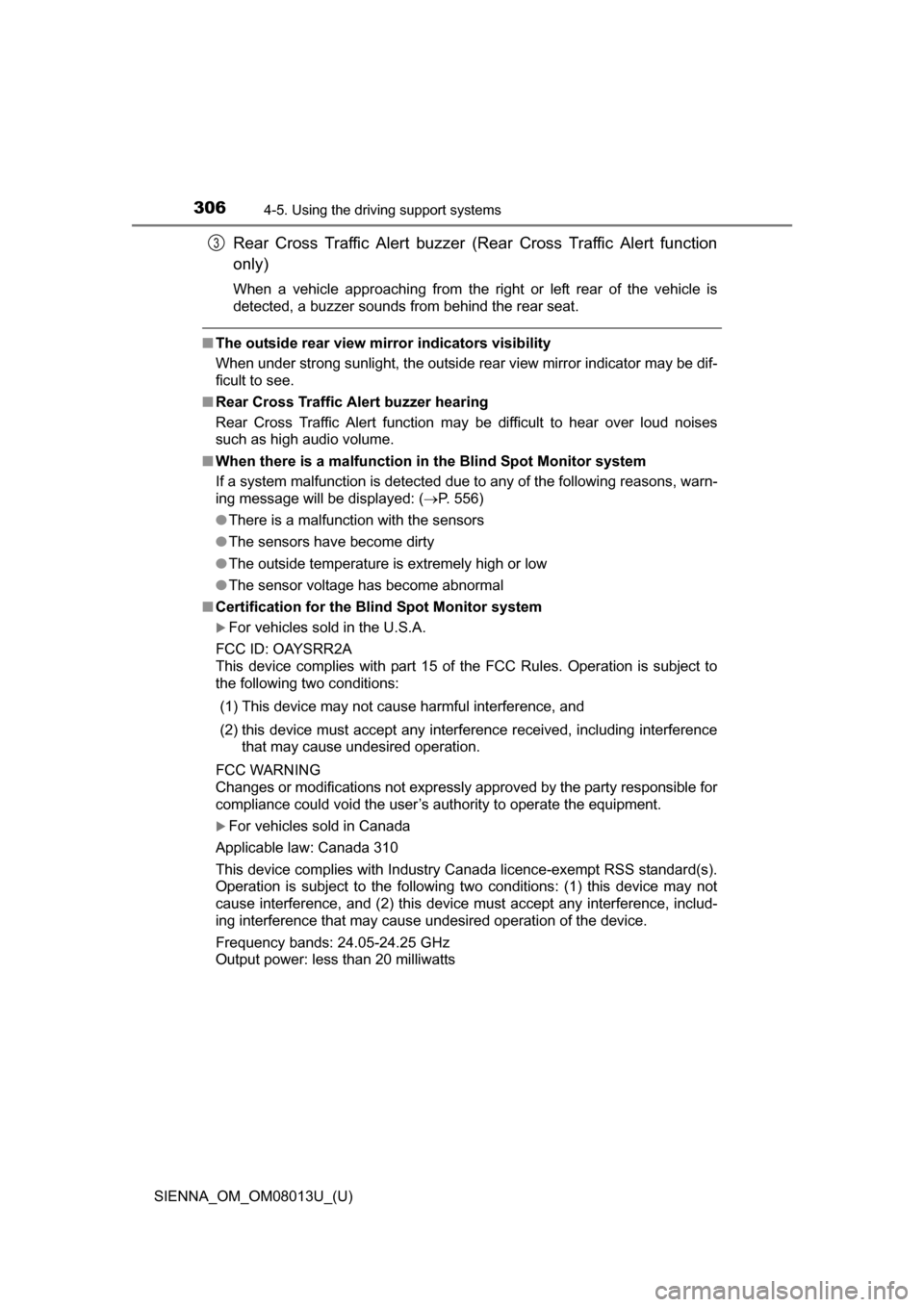
306
SIENNA_OM_OM08013U_(U)
4-5. Using the driving support systems
Rear Cross Traffic Alert buzzer (Rear Cross Traffic Alert function
only)
When a vehicle approaching from the right or left rear of the vehicle is
detected, a buzzer sounds from behind the rear seat.
■ The outside rear view mirror indicators visibility
When under strong sunlight, the outside rear view mirror indicator may be dif-
ficult to see.
■ Rear Cross Traffic Alert buzzer hearing
Rear Cross Traffic Alert function may be difficult to hear over loud noises
such as high audio volume.
■ When there is a malfunction in the Blind Spot Monitor system
If a system malfunction is detected due to any of the following reasons, warn-
ing message will be displayed: (P. 556)
● There is a malfunction with the sensors
● The sensors have become dirty
● The outside temperature is extremely high or low
● The sensor voltage has become abnormal
■ Certification for the B lind Spot Monitor system
For vehicles sold in the U.S.A.
FCC ID: OAYSRR2A
This device complies with part 15 of the FCC Rules. Operation is subject to
the following two conditions:
(1) This device may not cause harmful interference, and
(2) this device must accept any interference received, including interference that may cause undesired operation.
FCC WARNING
Changes or modifications not expressly approved by the party responsible for
compliance could void the user’s authority to operate the equipment.
For vehicles sold in Canada
Applicable law: Canada 310
This device complies with Industry Canada licence-exempt RSS standard(s).
Operation is subject to the following two conditions: (1) this device may not
cause interference, and (2) this device must accept any interference, includ-
ing interference that may cause undesired operation of the device.
Frequency bands: 24.05-24.25 GHz
Output power: less than 20 milliwatts
3
Page 316 of 668

316
SIENNA_OM_OM08013U_(U)
5-1. Basic OperationsAudio system types ........... 318
Audio system .................... 319
Steering wheel audio switches .......................... 321
AUX Port/USB Port ........... 323
Basic audio operations...... 324
5-2. Setup Setup menu....................... 326
General settings ................ 327
Audio settings ................... 329
Display settings ................. 330
Voice settings.................... 331
5-3. Using the Multimedia system
Selecting the audio source ............................. 332
List screen operation......... 333
Optimal use of the audio system ............................ 335
5-4. Using the radio Radio operation................. 336
5Audio system
Page 317 of 668

317
SIENNA_OM_OM08013U_(U)
5Audio system
5-5. Playing an audio CD and MP3/WMA/AAC discs
CD player operation .......... 338
5-6. Using an external device Listening to an iPod .......... 344
Listening to a USB memory device ....... 348
Using the AUX port ........... 353
5-7. Connecting Bluetooth
®
Preparations to use wireless
communication ................ 354
Registering a Bluetooth
®
audio player for the
first time .......................... 357
Registering a Bluetooth
®
phone for the
first time .......................... 358
Registering a Bluetooth
®
device.............................. 359
Connecting a Bluetooth
®
device.............................. 361
Displaying a Bluetooth
®
device details .................. 363
Detailed Bluetooth
®
system settings ............... 364 5-8. Bluetooth
® Audio
Listening to Bluetooth®
Audio ............................... 365
5-9. Bluetooth
® phone
Using a Bluetooth®
Phone ............................. 367
Making a call ..................... 369
Receiving a call ................. 372
Speaking on the phone ..... 373
Bluetooth
® phone
message function ............ 376
Using the steering wheel switches ................ 380
Bluetooth
® phone
settings ........................... 381
Contact/Call History Settings ........................... 382
What to do if... (Troubleshooting) ............ 391
5-10. Bluetooth
®
Bluetooth®......................... 395
5-11. Using the voice command system
Voice command system .... 401